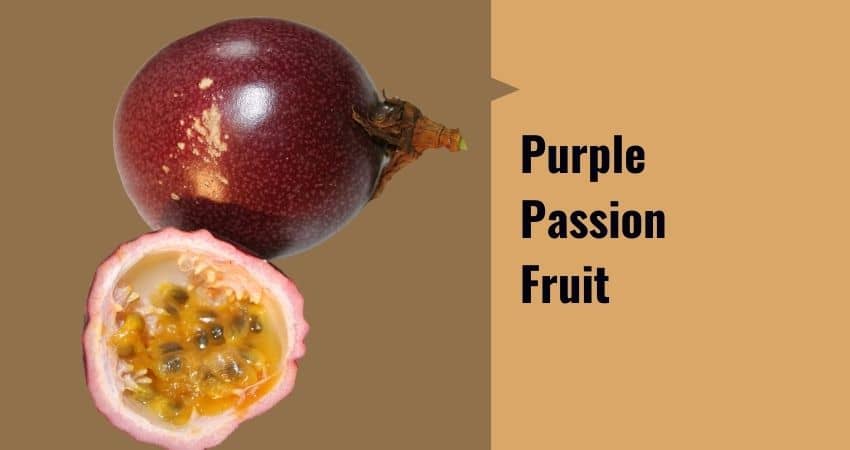How To Take Advantage of Purple Passion Fruit Benefits
Purple passion fruit is an edible fruit produced by the Passiflora edulis vine. This is the only member of the Passiflora plant family to bear edible fruits.
Passiflora edulis produces both Purple and Yellow passion fruits.
Thiese are different from the fruit that Passiflora Incarnata produces. The plant also produce a yellowish fruit. And although it is edible, it is not very popular.
Passiflora Incartnata blooms a beautiful purple flower that has medicinal value. So consumers seek out these flowers.

Purple passion flower is used for making herbal tea to help insomnia.
What Is Purple Passion Fruit?
Passiflora edulis is one of the more than 500 species of the Passiflora genus. The plantis native to Southern Brazil. But it is cultivated in several tropical and subtropical regions of the globe.
Both Yellow and Purple passion fruit are cultivated commercially mainly for their edible fruits. And India is now the world’s largest producer of Purple passion fruit.
The purple variety of passion fruit grows at higher altitudes and cooler environments than the yellow variety.
Purple Passion Fruit Vine
Passion fruit vine is a fast growing climbing vine that grows along fences and trellises. Wild passion vine can get to 25 or 30 feet long.
Besides the fruit the passion fruit vine blooms beautiful purple flowers with fringed edges. Passion flowers make beautiful ornaments.
And the Passion flowers are magnets for bees, butterflies, and hummingbirds.
Passion Fruit Season
In the tropics, Passion Fruit is available all year long. But, in places such as Southern California it is seasonal. Passion fruit season starts in June and ends in December.
Purple passion fruit is available earlier in the season than yellow passion fruit. Immature passion fruits are green but they turn purple, yellow, or orange as they ripen.
Both the Purple and Yellow passion fruit varieties grow in the Caribbean.
Purple Passion Fruit Taste
So what does Purple passion fruit taste like? The fruit has a combined sweet and slightly sour taste. Which is a common flavor among tropical fruits.
Some describe passion fruit taste as being similar to yellow kiwi or pineapple. Purple passion fruit taste is less acidic, more juicy and flavorful than the yellow variety.
Disclosure: This artcle contains affiliate links. It means if you make a purchase after clicking a link here, I may be paid a smaill commission. Thank you for your generosity.
Purple Passion Fruit Taste
So what does Purple passion fruit taste like? The fruit has a combined sweet and slightly sour taste. This taste is a common flavor among tropical fruits.
Some describe passion fruit taste as being similar to yellow kiwi or pineapple. The Purple variety taste is less acidic, more juicy and flavorful than Yellow passion fruit.
How to Eat Passion Fruit
The best way to eat Passion fruit is to cut it into halves, use a spoon to scoop out the pulp and enjoy it right from the shell. Incidentally the black seeds are edible.
But you can also sprinkle the seeds and pulp over frozen desserts and pastries. Or you can make a refreshing passion fruit drink.
Ad. Click Here to Buy Passion Fruit
Purple Passion Flower Fruit
The Purple passionflower plant aslo produces edible fruits. These are commonly known as Maypops in the Southern United States and other areas. Immature Maypop fruits are green egg-shaped fruits. But they turn yellowish when ripe.
When you cut the fruit open you will see a whitish pulp. There are flat, dark seeds also covered by the inside pulp. It is the inside of the fruit, including the seeds, that is edible.
The fruit is reportedly not as sweet or flavorful as those Passiflora edulis yields. However they do have a similar sweet and sour taste.
Some people have likened the maypop fruit taste to that of apricots. However, it is the Purple Passion flowers and leaves are more important to consumers than the fruit.
Purple Passion Flower
Purple Passion Flower is one of the common names for Passiflora Incarnata which is a different species of the Passiflora genus.
Other names for Passiflora Incarnata are Maypop, Wild Passionflower, Passionvine, Apricot vine and Purple Passionvine.
Just like other Passiflora species, Purple Passion Flower is a trailing vine. It blooms gorgeous lavender-purple flowers.

Purple Passion Flower Benefits
- Insomnia
- Pain
- Anxiety
- Nervousness
- Agitation
- High Blood Pressure
- Diarrhea
Passion Flower Uses
Purple Passionflower is mainly used for making herbal tea is made from the Passiflora Incarnata species.
Since the 15 hundreds Peruvian natives have used Passionflower tea as traditional medicine.
It reportedly was taken to treat liver problems. Passion flower tea was also used as a natural remedy for anxiety, agitation, pain, and nervousness.
Today many people use Passion Flower Teas for those same reasons.
It is one of the many Jamaican bush teas used on the island by people who have problems with sleeping.
Research shows Passion flower has active compounds that promote calm and anxiety.
So, some people use it to combat insomnia.
In fact, Passion flower was formerly approved in the United States by the FDA as an over the counter sleep aid.
However, in 1978 after a review of the classification, the FDA approval was withdrawn because manufactures of the sleep aid did not provide proof of the product’s safety.
But Passion Flower is still listed on the FDA’s Generally recognized as a safe substance list (GRAS).
How to Make Passion Flower Tea
To make passionflower tea add 2 teaspoons of dried passion flower to a cup of hot water.
Cover and let steep for about 10 minutes. Strain and drink at bedtime.
You can find passion flower tea for making tea in local health food stores and online. It is available in the form of dried passion flowers, teabags, or liquid extracts.
Can You Drink Passion Flower Tea Every Day? According to Webmd it is generally safe to take Passion tea for 7 nights.
Passion Flower Benefits
Passion flowers contain health benefits. It contains useful anti-inflammatory and antioxidant powers.
In addition, both Purple Passion Flower and Passion flower fruit and low calorie low, sodium foods.
And they have much needed vitamins and minerals too. These are some of those health benefits.
Vitamins A-Important for vision, growth, cell reproduction and immunity.
Vitamin C-Vital tp body’s healing process. Helps formation of blood vessels, cartilages and bones.
Vitamin B-Helps with turning food into energy. Also aids with nervous system functionality.
Potassium-Regulates heartbeat. Ensures that muscles and nerves function properly.
Iron-Responsible for the production of red blood cells and transportation of oxygen through the body.
Kaempferol-Strong Flavonoid found in foods such as kale, beans and spinach. The flavonoid is reputed to help prevent hardening of the arteries.
Studies report that the flavonoid can also lessen the risk of the formation of cancer cells.
Luteolin-Also a powerful Flavonoid found leaves of some plants. These plants include green peppers, parsley, rosemary, thyme and chamomile.
Research shows that Luteolin has strong anti-inflammatory power that can suppress inflammation in brain tissues.
These initial findings suggest that the consumption of a low dose of Passiflora incarnata, in the form of tea, yields short-term subjective sleep benefits for healthy adults with mild fluctuations in sleep quality.”
Source: Wiley Online Library
Passionflower Tea Side Effects
However, Purple passion flower does appear to be safe for most people when used as a food additive.
But although Passion flower is generally considered safe, some users have reported
Drowsiness, Dizziness and Confusion with use of passionflower products
In addition if you fall into any of the categories listed below you may want to limit the use of Purple Passion flower products.
Pregnancy: Passionflower has been known to cause early labor. If you are pregnant do not use passionflower as there are chemicals in the plant that can cause contraction of the uterus.
Breastfeeding: Women who are breastfeeding should avoid using passion flowers as there is no evidence to confirm that it is safe for lactating women.
Surgery: The sedatives in the passion flower plant may interact with anesthesia to increase drowsiness. It is wise to avoid using passion flowers during or after surgery.
Sedatives Medication: Taking passiflora with other sedative medications may cause too much sleepiness.
Conclusion
In summary, both Purple passion fruit and Purple passion flower produce fruits. Ironically the Purple Passion flower fruit is not purple at all. It is a light yellow when ripe.
The fruits of both these Passiflora species are delicious exotic fruits. They both have that sweet and sightly tart taste which is common in a lot of tropical fruits.
However when it come to Purple Passion Flower, it is the leaves and flowers that users find important. The reason is these sections of the vine have proven and potential medicinal value.
..>>>
Disclaimer: This website is for informational purposes only. Nothing stated or implied on the site is to be taken as medical advice. Please consult a professional healthcare provider for advice relating to your medical care.

